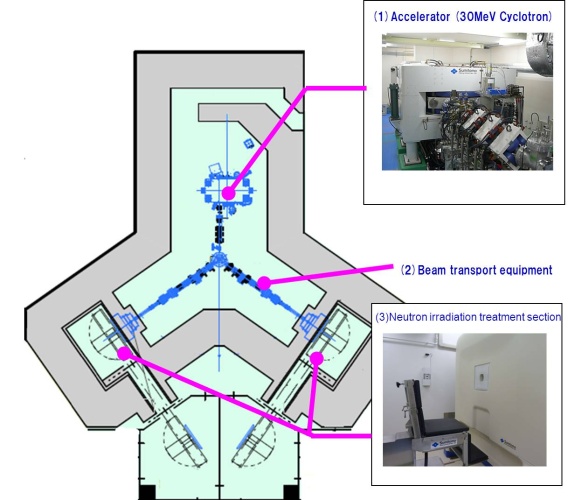World’s First Accelerator based Boron Neutron Capture Therapy (BNCT) System Ordered for a Hospital
March 11, 2013
Sumitomo Heavy Industries, Ltd. (hereinafter referred to as “SHI”; President: Yoshinobu Nakamura) received an order from the Southern Tohoku Research Institute for Neuroscience (Director: Kazuo Watanabe) in Fukushima Prefecture for a boron neutron capture therapy (BNCT) system that irradiates neutrons, produced by an accelerator, onto an affected area. This world first, cutting-edge equipment can be used as a dedicated system in the field of medical care.
This cancer treatment, referred to as BNCT*, is a therapy performed to selectively destroy cancer cells that have been injected boron (Boron-10) compound. This is done by using a minute amount of neutrons that are irradiated to cause a nuclear reaction in the boron injected cancer cells. This unique radiation therapy is different from other radiation therapies, as it is capable of destroying only cancer cells, whereas normal cells in the vicinity are not damaged.
*BNCT is an abbreviation for Boron Neutron Capture Therapy.
Conventional BNCT systems involve an experimental nuclear reactor to produce neutrons, however this BNCT uses an accelerator (cyclotron) instead of a nuclear reactor to produce neutrons, which has made it possible to install the system in a hospital. It is therefore expected that this order becomes the first step towards the extension of BNCT systems in the future.
This BNCT system will be installed on the premises of the Southern Tohoku General Hospital of the Southern Tohoku Research Institute for Neuroscience (Koriyama City in Fukushima Prefecture) and clinical trials are planned to commence from FY2015, with the aim of acquiring Approval from the Ministry of Health, Labor and Welfare for a Medical Equipment. The Southern Tohoku General Hospital, one of the foremost hospitals in Japan, has been designated as a Regional Cancer Medical Care Base Hospital and Regional Medical Aid Hospital, equipped with cutting edge treatment systems, such as PET for cancer diagnosis, gamma knife for brain tumor treatments, as well as a proton beam therapy treatment system, installed for the first time in a private hospital in Japan. With the new installation of this BNCT system, this hospital will become unprecedented in the world for cutting edge general treatment facilities.
SHI has been continuing the research and development of PET, proton beam therapy cancer treatment systems and other cutting edge cancer medical technologies focusing on the accelerator for over 30 years. This BNCT system is also a joint technology development, in collaboration with the Kyoto University Research Reactor Institute and Stella Pharma Corporation. Through the new conversion of this BNCT system into medical equipment we continue to contribute towards the extension of general cutting edge technologies, from cancer diagnosis to treatment, ahead of the world.
The BNCT system layout and equipment configuration is as described below:
(1) Accelerator (30MeV Cyclotron)
(2) Beam transport equipment
(3) Neutron irradiation treatment section
[Accelerator]
Protons are accelerated to energy level 30MeV*1 by a cyclotron*2 dedicated for cancer treatment.
[Beam transport equipment]
Protons generated and accelerated by the Cyclotron are transported to the irradiation equipment of the neutron irradiation treatment section.
[Neutron irradiation treatment section]
The transported proton beam is irradiated onto the target to produce neutrons. Neutrons with excessive energy at this stage, is decelerated until the energy is lowered to an appropriate level for treatment and then irradiated to the affected cancer site.
*Note 1: MeV: Mega Electron Volts.
Electron volt (eV) is a unit of energy. One million eV is equivalent to 1MeV.
*Note 2: Cyclotron:
This is a type of circular accelerator. This equipment is capable of accelerating protons, the nuclei of hydrogen atoms, to about 70% of the speed of light.
*Photographs (1) and (3) above depict pieces of equipment installed at Kyoto University Research Reactor Institute.

